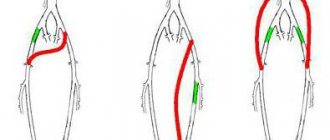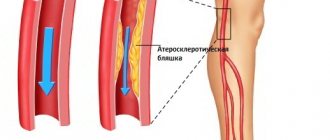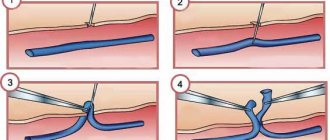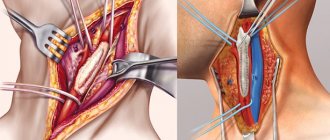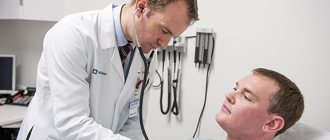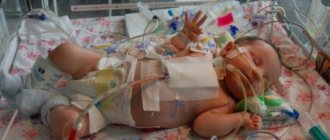Cardiac bypass surgery is the redirection of blood supply from clogged coronary arteries through surgery. The heart muscle pumps blood throughout the body to nourish the body's cells and provide oxygen. The heart itself is supplied with it through the myocardium through the two main coronary arteries.
Stress, an unhealthy lifestyle and an unbalanced diet can lead to the development of atherosclerosis, decreased patency of the coronary arteries, loss of elasticity and accumulation of cholesterol, calcium and fat in the vessels.
This, in turn, leads to a lack of nutrition of the heart, death of its parts, tissue necrosis and deadly heart attacks and strokes, which can be avoided by performing coronary artery bypass surgery.
Concept and essence
The principle of this difficult operation was developed by the Soviet scientist and doctor Vladimir Demikhov, under his authorship in 1960 the first treatise on transplantology was published, which was almost immediately translated into English. The coronary arteries get their name because of the “crowning” location of their connection to the heart.
During the illegal autopsies of corpses carried out by Leonardo da Vinci in 1507 to study anatomy, the scientist noticed that the cause of death could be plugs in these arteries. Sclerotic plaques most often appear in the area of the left one closest to the myocardium, causing angina pectoris and even heart attack.
The idea of providing the heart with blood in a roundabout way came to Demikhov during the Great Patriotic War, when the young physiologist was mobilized as a pathologist in a hospital at the front. The plan was to transfer the thoracic internal artery to the heart and suture it to the coronary artery in the area below the plug formation, this graft is called a bypass.
In modern bypass surgery, suturing is also performed with the radial artery of the arm and the great saphenous vein. The first surgical experiments were carried out in order not to exceed the extremely short time permissible for the heart without blood supply.
Nowadays, a device is used that provides artificial nutrition to the heart, a minimally invasive method, or the beating heart is operated on.
In the early stages, blockages of blood vessels and arteries are treated with medications, lifestyle coordination and medical procedures. Cardiac bypass is a highly effective operation on the arteries and heart muscle, widespread throughout the world, to restore nutrition to the heart by bypassing the blood supply, used in advanced cases.
It should not be confused with stenting, which involves installing an expanding frame into narrowed vessels and tracts.
Coronary artery bypass grafting is divided into the following types:
- The most common standard coronary artery bypass surgery using an artificial blood supply device. In a small number of cases, it can cause postoperative complications. The price varies from 70 to 450 thousand rubles.
- Coronary artery bypass surgery is safer for the body without artificial blood supply. It requires highly qualified and experienced surgeons who do not stop the heart while operating on the affected area. The cost ranges from 60 to 400 thousand rubles.
- Coronary artery bypass surgery with replacement of the affected valve will require from 70 to 410 thousand rubles.
- Hybrid bypass surgery, performed for extensive lesions of the cardiovascular system and including various types of additional surgical procedures. The final price depends on their type and quantity.
The prices given are approximate; the cost of the operation is determined by the pricing policy of the organization performing it.
Rehabilitation
At the early stage of recovery, the patient is in intensive care for 2 to 10 days. Plus or minus as needed. All this time, doctors are treating the stitches.
- For a period of up to six months, the patient is prohibited from heavy physical activity. Maximum 3-4 kg without bending, distributing the weight on both hands. Because the bones of the sternum are only fused. You shouldn't create additional problems for yourself. To alleviate the condition, you can wear special bandages.
- You need to walk, but overworking is prohibited. Slow step. At the same time, in order to avoid venous-lymphatic stagnation, it is recommended to wear special compression stockings.
- For a couple of months, you need a diet high in iron, vitamins and protein, but overeating is excluded, as this will put an increased burden on the heart.
Attention:
While a person is in the hospital and cannot move normally, breathing exercises are recommended. This will prevent the patient from getting pneumonia.
- After discharge, physical activity is increased gradually. As soon as the bones of the sternum have fused, you can engage in exercise therapy.
Rehabilitation continues after discharge in a special center. Once a year the patient is recommended to visit the sanatorium.
Advantages and disadvantages
Coronary artery bypass grafting has a beneficial effect on the patient's quality of life, being a more effective and longer-lasting method compared to, for example, stenting or balloon angioplasty.
The need for repeated visits to the doctor due to identical health problems arises much less frequently than after identical cardiac procedures with a lesser degree of surgical intervention. This type of treatment is prescribed mainly when the patency of three or more arteries deteriorates; in other cases, stent installation or angioplasty is used.
Performed by opening the chest, bypass surgery makes it possible to more accurately determine the location of the plaques. The disadvantages of this treatment practice are the higher cost than methods performed without open access. Also, the application of shunts has a greater number of contraindications, possible complications and a longer recovery period.
How is coronary artery bypass surgery performed?
What is cardiac bypass surgery?
The essence of the method is that thanks to the shunt, a bypass path is created, ensuring free flow of blood from the aorta to the artery, bypassing the blocked part.
For this purpose, donor material from the patient himself is used: the thoracic artery, radial artery or great saphenous femoral vein.
The best option is the thoracic artery, since it is minimally susceptible to atherosclerosis.
Coronary artery bypass grafting can be single or multiple, based on the number of obstructed coronary vessels.
ATTENTION! There are alternative ways to correct the condition of clogged vessels. These include drug therapy, coronary angioplasty and stenting.
Indications
Deterioration of vascular patency is a sign of the disease atherosclerosis, which forms atheromatous formations in them. Subsequently, they become overgrown with connective tissue, narrowing the duct of the vessel until its final blockage.
Heart bypass surgery is performed when the duct in a blood vessel is narrowed due to a blockage.
This disease is often confused with Menkenberg's arteriosclerosis, characterized by salt deposits in the middle arterial lining and lack of plaque. It differs in that it does not clog blood vessels, but causes aneurysms.
The use of bypass surgery in the treatment of Menkenberg arteriosclerosis does not guarantee cure. The consequence of atherosclerosis is coronary heart disease, which is expressed in a pathological lack of nutrition of the heart and leads to myocardial damage.
Cardiac bypass surgery is a surgical technique, the prerequisites for which are:
- arterial stenosis caused by atherosclerosis;
- three coronary arteries affected by stenosis;
- atherosclerosis of the trunk of the left coronary artery;
- severe left ventricular heart failure;
- deterioration of blood supply with narrowing of the lumen of the coronary arteries by atheromatous formations by 70% or more;
- angina pectoris incompatible with drug treatment;
- the impracticability of using angioplasty or stenting of blocked coronary arteries;
- their damage by atherosclerosis, spreading to the heart valves;
- recurrence of deformation and blockage of blood vessels, according to statistics, occurs no earlier than 5-12 years after bypass surgery.
Atherosclerosis occurs chronically, coronary heart disease can be expressed both chronically and acutely. The most effective treatment for advanced atherosclerosis and coronary artery disease is surgery.
Registration of disability
After cardiac bypass surgery, temporary incapacity for work (on sick leave) is issued for up to four months. After this, patients are sent to MSE (medical and social examination), during which it is decided whether to assign a particular disability group to the patient.
Group III is assigned to patients with an uncomplicated course of the postoperative period and with angina pectoris classes 1-2, as well as without or with heart failure. It is allowed to work in professions that do not pose a threat to the patient’s cardiac activity. Prohibited professions include working at heights, with toxic substances, in field conditions, and being a driver.
Group II is assigned to patients with a complicated course of the postoperative period.
Group I is assigned to persons with severe chronic heart failure requiring care from others.
Contraindications
This operation does not work under the following conditions:
| Individual contraindications | Common not recommended serious illnesses |
| Symptoms of clinical heart failure | Kidney failure |
| Obesity | Uncompensated diabetes mellitus |
| An acute decrease in the left ventricular ejection fraction to a level of 30% or lower, which occurred due to scar damage. | Chronically nonspecific lung diseases (CNLD) |
| Damage to all coronary arteries of a diffuse type, observed in Menkenberg arteriosclerosis. | Oncological diseases |
These indicators are relative. This operation is not recommended for elderly patients either, but in this case the conditions that determine the possibility of bypass surgery are rather the risks during the surgical intervention and postoperative risks.
An obstacle to the application of shunts may also be the severe condition of the person being operated on, uncontrolled arterial hypertension, incurable illnesses, stenosis of large arteries, which has widely spread both in many areas and in smaller vessels, and a stroke that occurred shortly before the operation.
Until recently, a history of acute myocardial infarction categorically prevented bypass surgery; today, the possibility of performing it under these conditions is determined by the doctor’s assessment.
Contraindications for surgery
The following conditions may become an obstacle to bypass surgery:
| From the side of the heart | General contraindications |
|
|
What examinations need to be completed
Cardiac bypass surgery is a treatment method performed both as a planned option and as an emergency surgical intervention.
Emergency examinations include:
- identification of blood group and its Rh factor;
- electrocardiography;
- establishing the degree of blood clotting.
The examinations required for the planned operation include:
- general blood test;
- checking for the presence of immunodeficiency viruses and hepatitis;
- general urine analysis;
- ECG;
- identifying the level of blood clotting;
- establishing the blood group and its Rh factor;
- biochemical blood test;
- taking x-rays of the chest area;
- echocardioscopy.
Of particular importance is a preliminary thorough examination of the aorta, including visual examination, palpation diagnostics and ultrasound examination.
Transesophageal echocardiography and epiaortic examination using ultrasound are the most detailed ways to determine the condition of the aortic walls, help to identify the necessary nuances in the operation and the most appropriate way to treat the patient.
When prescribing regular drug treatment, in particular anticoagulants, or chronic illnesses, you should definitely inform your doctor about this in advance. Prices for examinations vary depending on the chosen medical institution; clinical blood tests, according to the decision of the medical advisory commission, are carried out free of charge.
How much does bypass surgery cost?
CABG surgery is a high-tech type of medical care, so its cost is quite high.
Currently, such operations are carried out under quotas allocated from the regional and federal budgets, if the operation is performed routinely for people with coronary artery disease and angina, and also free of charge under compulsory medical insurance policies if the operation is performed urgently for patients with acute myocardial infarction.
To receive a quota, the patient must undergo examination methods confirming the need for surgical intervention (ECG, coronary angiography, cardiac ultrasound, etc.), supported by a referral from the attending cardiologist and cardiac surgeon. Waiting for a quota can take from several weeks to a couple of months.
If the patient does not intend to wait for a quota and can afford the operation for paid services, then he can contact any public (in Russia) or private (abroad) clinic that performs such operations. The approximate cost of bypass surgery is from 45 thousand rubles. for the surgical intervention itself without the cost of consumables up to 200 thousand rubles. with the cost of materials. When combined with heart valve replacement and bypass surgery, the price ranges from 120 to 500 thousand rubles, respectively. depending on the number of valves and shunts.
Preparation
Standard preoperative measures include medical procedures, restrictions on food intake, medications, and treatment of the area where surgical procedures are performed. The patient must sign a document consenting to the operation. Hair should be shaved in the areas being operated on, including the areas of the limbs where future shunts will be taken.
On the day before the operation, you can allow yourself water and a light dinner; after midnight you cannot drink. It is also necessary to consult an anesthesiologist, an operating doctor and a specialist in therapeutic breathing and physical exercises. After dinner, the patient takes the last dose of medication. You should take a shower at night and in the morning and cleanse your intestines.
Cholesterol-lowering drugs, statins, clopidogrel and aspirin are mainly recommended for patients before CABG; the latter two should be discontinued from 10 days to a week before bypass surgery.
The intake of medications and their types is regulated by the attending physician. The dosage of statins is usually 10-80 mg per day with dinner. Medicines are also used to reduce risk factors and the severity of coronary artery disease and atherosclerosis.
Pre-procedural examination
Before performing coronary artery bypass surgery, clinicians should carefully review the patient's medical history for factors that may lead to complications, including the following:
- Recent myocardial infarction
- Previous cardiac surgery
- Conditions that may lead to bleeding
- Renal dysfunction
- Cerebrovascular disease, including carotid murmurs and transient ischemic attack
- Electrolyte disturbances that may predispose the patient to dysrhythmia
- Infectious processes, including urinary tract infection, etc.
- Chronic obstructive pulmonary disease (COPD) or infection.
Standard preoperative investigations may include:
- General blood analysis
- Study of creatinine and electrolyte levels (anomalies are discussed and corrected with the anesthesiologist)
- Liver function tests
- Methicillin-resistant Staphylococcus aureus test
- Chest X-ray
- Electrocardiography (ECG)
- Echocardiography or ventriculography (to assess left ventricular function)
- Coronary angiography (to determine the extent and location of CAD)
Procedure
In the period of an hour to half an hour before the start of surgery, the patient in the department takes medicinal sedatives, then he is taken on a gurney and placed on the operating table. Here, catheterization of the bladder and venous input are equipped, the patient is connected to sensors that monitor blood pressure, ECG, respiratory rate and blood oxygenation.
Medicines are administered, after which the patient falls asleep. The anesthesiologist establishes artificial respiration by incubating the trachea. The first step in a standard bypass procedure is to open the chest to access the heart, then isolate the left thoracic artery and remove veins from the limbs for bypass surgery.
The patient is connected to an artificial blood supply machine, stopping the heart using cardioplegia; devices that stabilize the treated area of the myocardium are used to perform CABG. During an operation without cardiac arrest, IR is not used; for convenience, the doctor temporarily fixes the area of the beating heart using equipment.
This technique is characterized by shorter rehabilitation and the absence of harm to the body from IR.
The final steps of the surgical intervention are turning off artificial circulation, returning the heart to normal operation by temporarily connecting it to special electrodes, and installing a drainage while suturing the chest. The time of CABG depends on the individual characteristics of the body, the number of shunts created, and ranges from 4 to 6 hours.
The operated patients are placed under observation in the intensive care unit for a period of about 2 days. The limb from which the shunt was removed may lose sensation for a short time.
After standard, professionally performed coronary artery bypass surgery without complications, the patient may experience only mild discomfort in the chest area and a slight degree of dizziness.
Symptoms
After surgery, patients are admitted to the intensive care unit, where urinary tract catheterization and artificial ventilation are performed. Painkillers are administered and antibiotics . Heart function is assessed on a monitor in the form of electrocardiography. After stabilization of the patient’s condition, the patient is transferred to independent feeding and breathing. The range of movements increases gradually, step by step.
At first, patients are bothered by chest pain, which is due to the specifics of the operation being performed, because it is open to the public. As the sternum grows together, the pain subsides. Also, discomfort is observed in the area where the vein was taken. All symptoms are temporary and the patient gradually returns to his usual lifestyle.
Recovery after
After surgery, you should gradually increase your physical activity, walking more and more distances every day. The energy consumption of an untrained heart significantly exceeds the activity of the heart muscle of a person leading a healthy lifestyle.
After the shunts are placed, doctors advise patients about when they can start walking, how they should move, lie down, stand up and turn in bed so as not to damage the stitches. Heart bypass surgery is an operation that can cause mood swings.
Those undergoing surgery should not participate in stressful situations or experience anxiety; it is recommended to develop control over emotions. At first, it is necessary to avoid lifting objects weighing more than 2 kg and straining the shoulder girdle. Discharge from the hospital usually occurs by the end of the second week; full recovery will take about 2-3 months.
This is influenced by the age and health status of the patient. Recommendations for behavior and lifestyle after bypass surgery, as well as appropriate medications, dosage and time of taking them should be prescribed by a doctor on an individual basis.
In most cases, long-term or continuous use of aspirin, beta blockers, cholesterol-lowering drugs, or statins is prescribed. Some of the medications that, according to the American Heart Organization, should be used to prevent and prevent the development of atherosclerosis, coronary artery disease and recovery after coronary artery bypass grafting.
Table:
| Medicine | Daily dose | Price |
| Aspirin | from 81 to 325 mg | from 73 rub. |
| Clopidrogel | 75 mg | from 227 rub. |
| Prasugrel | 10 mg | 3730 rub. |
| Ticagrelor | 90 mg | from 2821 rub. |
| Warfarin | INR 2.0-3.0, goal 2.5 | from 88 rub. |
| Atorvastatin | 40-80 mg | from 113 rub. |
| Rosuvastatin | 20-40 mg | from 237 rub. |
| Bisoprolol | 5-20 mg | from 83 rub. |
| Metoprolol | 50-200 mg | from 26 rub. |
| Carvedilol | 25-50 mg | 106 rub. |
These drugs are not general medications and are used depending on the individual health characteristics of the patient. You should not take medications without a doctor’s prescription and exceed the daily dosage of medications even if there are omissions in the dosage schedule.
Lifestyle after surgery
The postoperative wound begins to heal within 7-10 days after bypass surgery. The sternum, being a bone, heals much later - 5-6 months after the operation.
In the early postoperative period, rehabilitation measures are carried out with the patient. These include:
- Diet food,
- Breathing exercises - the patient is offered something like a balloon, which, when inflated, the patient straightens the lungs, which prevents the development of venous congestion in them,
- Physical gymnastics, first lying in bed, then walking along the corridor - nowadays they strive to activate patients as early as possible, if this is not contraindicated due to the general severity of the condition, to prevent stagnation of blood in the veins and thromboembolic complications.
In the late postoperative period (after discharge and subsequently), the exercises recommended by the physical therapy doctor (physical therapy doctor) continue to be performed, which strengthen and train the heart muscle and blood vessels. Also, for rehabilitation, the patient must follow the principles of a healthy lifestyle, which include:
- Complete cessation of smoking and drinking alcohol,
- Compliance with the basics of a healthy diet - exclusion of fatty, fried, spicy, salty foods, greater consumption of fresh vegetables and fruits, dairy products, lean meats and fish,
- Adequate physical activity - walking, light morning exercises,
- Achieving the target blood pressure level using antihypertensive drugs.
How long will the results last?
Performing CABG does not mean that coronary heart disease will completely disappear, and the behavior and lifestyle that led to the operation can be left unchanged. The duration of the period of improved quality of life after surgery directly depends on compliance with the doctor’s recommendations, getting rid of bad habits and proper nutrition.
A shunt formed from the femoral saphenous vein can last on average 10 years, as can a shunt from a thoracic artery. Arteries from the forearm maintain good patency for 5 years. With poor diet and bad habits, these indicators can take about a year.
Forecast
The prognosis after bypass surgery is determined by a number of indicators such as:
- Duration of operation of the shunt. The most long-term option is the use of the internal mammary artery, since its viability is determined five years after surgery in more than 90% of patients. The same good results are observed when using the radial artery. The great saphenous vein has less wear resistance, and the consistency of the anastomosis after 5 years is observed in less than 60% of patients.
- The risk of developing a myocardial infarction is only 5% in the first five years after surgery.
- The risk of sudden cardiac death is reduced to 3% in the first 10 years after surgery.
- Physical exercise tolerance improves, the frequency of angina attacks decreases, and in the majority of patients (about 60%), angina does not return at all.
- Mortality statistics – postoperative mortality is 1-5%. Risk factors include preoperative (age, number of previous infarctions, area of myocardial ischemia, number of affected arteries, anatomical features of the coronary arteries before intervention) and postoperative (nature of the bypass used and time of cardiopulmonary bypass).
Based on the above, it should be noted that CABG surgery is an excellent alternative to long-term drug treatment of coronary artery disease and angina pectoris, as it reliably reduces the risk of myocardial infarction and the risk of sudden cardiac death, as well as significantly improves the patient’s quality of life. Thus, in most cases of bypass surgery, the prognosis is favorable, and patients after cardiac bypass surgery live for more than 10 years.
Possible complications after heart bypass surgery
The effectiveness of shunt placement can be compensated by common postoperative complications of varying severity. People who have contraindications to this operation, female patients and patients with hypertension are most predisposed to them.
Atrial fibrillation is the most common complication, occurring in almost half of patients. It, in turn, increases the risk of stroke and cardiogenic shock, which can result in death, by four and three times, respectively.
Those undergoing cardiac arrest with CPB are not insured against deterioration of the blood supply to the brain, the probability of which ranges from 1.5 to 4%. Postoperative atrial fibrillation, as a rule, disappears spontaneously during the first month and a half.
30% of those operated on using cardiopulmonary bypass experience short-term cognitive imbalance, 10% exhibit delirium. This refers to neurological complications, the prerequisites for which are pathological conditions of the central nervous system and celebrovascular diseases.
Cardiac bypass surgery is a method that can lead to inflammation, the development of which can lead to multiple organ dysfunction. The progression of this complication is due to endotoxemia, combination of blood with extracorporeal blood supply, reperfusion contact after removal of the clamp crossing the aorta, and ischemia.
In 2-3% of cases, CABG can cause acute renal failure in patients with chronic heart failure, female patients, black patients, patients suffering from diabetes mellitus or with a low level of left ventricular ejection fraction, or aggravate this disease if it is present. in those undergoing surgery.
From 10 to 20% of people suffering from obesity or chronic obstructive bronchitis (COPD) are susceptible to postoperative nosocomial infections.
Thorough planning of the procedure for applying shunts, postoperative recovery, and a responsible attitude of the patient in preparing himself for surgery will help prevent the occurrence of the described threats.
Important factors determining the success of this difficult operation, its cost and the absence of complications are the level of the medical institution performing it and the qualifications of the medical staff. Performing coronary artery bypass surgery is, first of all, a serious revision of lifestyle and careful adherence to medical prescriptions.
Operated patients must follow the prescribed regimen of medications of varying durations. By following these simple conditions, you can significantly improve the quality and length of life after surgery.
Consequences and complications
Complications can develop if the patient has concomitant pathology:
- diabetes;
- pathology of the renal system;
- diseases of the pulmonary system.
Most often, after surgery, bleeding occurs in the anastomotic area and rhythm disturbances are recorded. Possible complications:
- acute circulatory disorder in the brain and myocardium;
- thrombosis of the venous bed;
- renal failure;
- local complications in the form of wound infection and the formation of postoperative keloid scars;
- closure or narrowing of the shunt.
Frequently asked questions about CABG
What is heart bypass surgery?
This is the name for using the arm artery (radial) to create a cardiac shunt - a new vessel through which the myocardium will receive good nutrition.
Is coronary bypass surgery possible without opening the chest?
This is possible with a minimally invasive operation - the surgeon does not completely open the chest, but makes a small incision in the intercostal space and inserts the necessary instruments through it.
What is the period of sick leave after CABG?
The duration of temporary disability in each case is established by the medical commission. Most patients achieve complete recovery in 1-1.5 months. The maximum duration is 4 months, but if there are concomitant diseases or complications, the sick leave is extended or a disability group is established.
When can you sleep on your side after CABG?
If the operation was performed in the usual way with the opening of the chest, then you can turn over to either side after 10 days. With a minimally invasive approach, there are usually no restrictions on movements.
How long do you live after heart bypass surgery?
Installing shunts helps prolong life. It eliminates the risk of heart attack and its complications. There are no deadlines. If you do not follow the recommendations on diet, physical activity, quitting smoking and alcohol, then the result of the operation is sharply reduced.
Is coronary artery bypass surgery worth it or not?
Currently, coronary artery bypass grafting is considered the most effective way to restore blood circulation in the heart. The operation allows you to lead a lifestyle close to that of healthy people.
How many times can you do CABG?
If the shunt is clogged or the effect of the operation is unsatisfactory, it may be repeated. But you need to know that if the patient does not follow the recommendations to eliminate risk factors for blockage (diet, medications, exercise), smokes, or suffers from alcoholism, then it will be denied. There is no limit on the number of transactions.
How much does CABG cost in Moscow?
The price range is from 100 to 700 thousand rubles. The cost of coronary artery bypass surgery is influenced by the category of the clinic, the method of implementation, the number of required bypasses, where the restoration will take place (in the clinic or at the place of residence).
How long does heart bypass surgery take?
The average time is 4-5 hours. The duration of surgery for CABG depends on the method and the development of complications.
What is the success rate for CABG heart surgery?
In specialized cardiac surgery clinics, the operation is successful in 98% of patients, and after 10 years, 95% of arterial shunts remain open.
Thus, treatment of coronary artery disease using coronary artery bypass grafting helps patients restore their health if, after the operation, recommendations on proper nutrition and physical activity and giving up bad habits are followed.
Indications for use
In some diseases, blood flow in the heart is disrupted and large vessels become blocked. They stop pumping blood fully, and a narrowing of the lumen occurs. The muscles weaken and sag greatly, dying in certain areas due to lack of oxygen. Cardiologists call this process “ischemia.” It is irreversible and greatly undermines human health. Even with constant use of drugs, there remains a high risk of myocardial infarction and death during the next attack.
Coronary artery bypass grafting is a specially designed operation in which the heart surgeon creates artificial ducts to allow blood to flow to the heart muscles. These bypasses are called "shunts". With their help, healthy vessels are connected into one network, and the blood circulation process is restored, bypassing the clogged vein.
Indications for coronary bypass surgery:
- narrowing of blood vessels due to congenital defects;
- aneurysm in coronary sclerosis of small vessels;
- angina pectoris at stage 3 or 4;
- consequences of myocardial infarction;
- blockage of more than 2 vessels with plaques in atherosclerosis.
Surgery is prescribed only in difficult situations when all medical treatment techniques have failed. The essence of the method is to transplant a small section of a healthy artery used from the patient’s thigh. The transplanted blood vessel, unlike artificial materials, quickly takes root and begins to actively function within a few days after manipulation.
Useful: What not to do during menstruation
Heart shunts
Cardiac shunts create a new vascular pathway for blood movement. It is placed by the surgeon to bypass the blocked artery. Helps improve blood supply to the area of the heart muscle that does not receive nutrition. This helps prevent heart attacks and reduce the number and severity of angina attacks. In patients with myocardial ischemia (lack of blood supply), the risk of sudden death is reduced.
The patient's own blood vessels are used for shunts. It could be:
- part of the radial artery of the arm;
- internal arterial branches of the thoracic;
- saphenous vein of the leg (from the lower leg or thigh).
One end of the shunt is connected to the aorta, and the other to the branch of the heart that is blocked. The operation takes place when the patient is connected to the artificial heart-lung system, but it is possible without it. The heart's work is stopped or carried out on the contracting myocardium.
Possible complications
Complications after CABG are quite rare. Usually they are expressed in the form of swelling or inflammation that occurs in response to the transplantation of one's own tissue.
In more rare cases, the following complications of CABG are possible:
- bleeding;
- infectious complications;
- incomplete fusion of the sternum;
- myocardial infarction;
- stroke;
- thrombosis;
- memory loss;
- renal failure;
- keloid scars;
- chronic pain in the operated area;
- postperfusion syndrome (one of the forms of respiratory failure).
Minimally invasive coronary artery bypass grafting
Coronary bypass surgery is called minimally invasive if the chest is not opened, but a small incision is made to the left of the sternum in the intercostal space. The operation becomes less traumatic, and healing is faster. Most often, bypass surgery takes place on a beating heart without connection to a heart-lung machine. It is prescribed for blockage of 1-2 coronary branches on the anterior wall of the heart.
This technique also has a drawback - it is impossible to ensure complete restoration of coronary blood flow. Currently, the opinion of scientists about the need for such an effect has changed. It has been established that the main vessel that should receive adequate nutrition is the branch of the left coronary artery passing along the septum between the ventricles. In this case, the long-term results of complete and partial normalization of blood flow will be almost the same.
